7 Best Data Annotation & Labeling Tools In 2025
In 2025, leading data annotation tools include Labellerr, Labelbox, SuperAnnotate, Appen, V7, Amazon SageMaker Ground Truth, and Dataloop.
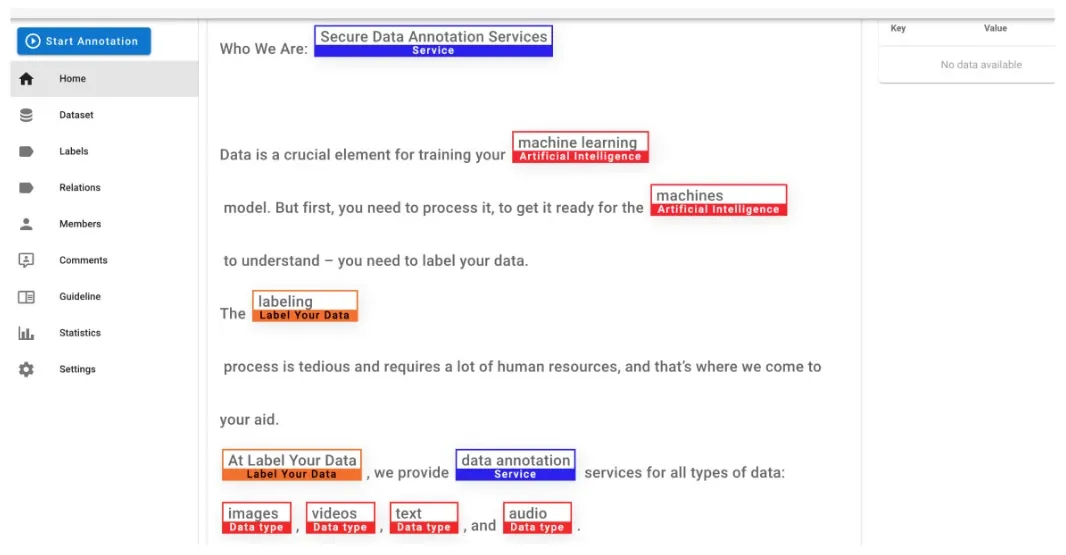
Are you searching for the most efficient annotation tools in 2025? Look no further than Labellerr's enterprise-grade annotation solution. Our platform helps data science teams reduce annotation time by 80% while maintaining superior data quality. Unlike other annotation tools, Labellerr offers unmatched security with on-premise deployment options and AI-powered automation. Start your free trial today and experience why leading companies trust our annotation tools for their mission-critical AI projects.
Using machine learning (ML) to develop useful applications has gained a lot of attraction in the field of artificial intelligence. But did you realize that the interesting stuff, like training models or experimenting with new ideas, doesn't account for a significant portion of the work—more than 80%, in fact? Rather, the majority of their work is spent preparing the data by ML engineers and data scientists. They name it, arrange it, and address any problems to make it "AI-ready."
Data Annotation techniques are useful in this situation. These technologies aid in labelling, organising, and controlling the data to prepare it for AI. It's possible, nevertheless, that the current toolset falls short of meeting all the requirements for intricate AI applications.
Six characteristics of data annotation tools have been shown to be very important for developing contemporary AI systems. These consist of annotation software, AI data management and organisation, safe tool integration, project management, quality assurance, and task automation.
The best annotation tools are highlighted in this article and can be customised to fit your needs. It explores the key elements that improve the capacity of a data labelling tool to build reliable AI systems.
Table of Contents
Top 7 Data Annotation Tools
1. Labellerr
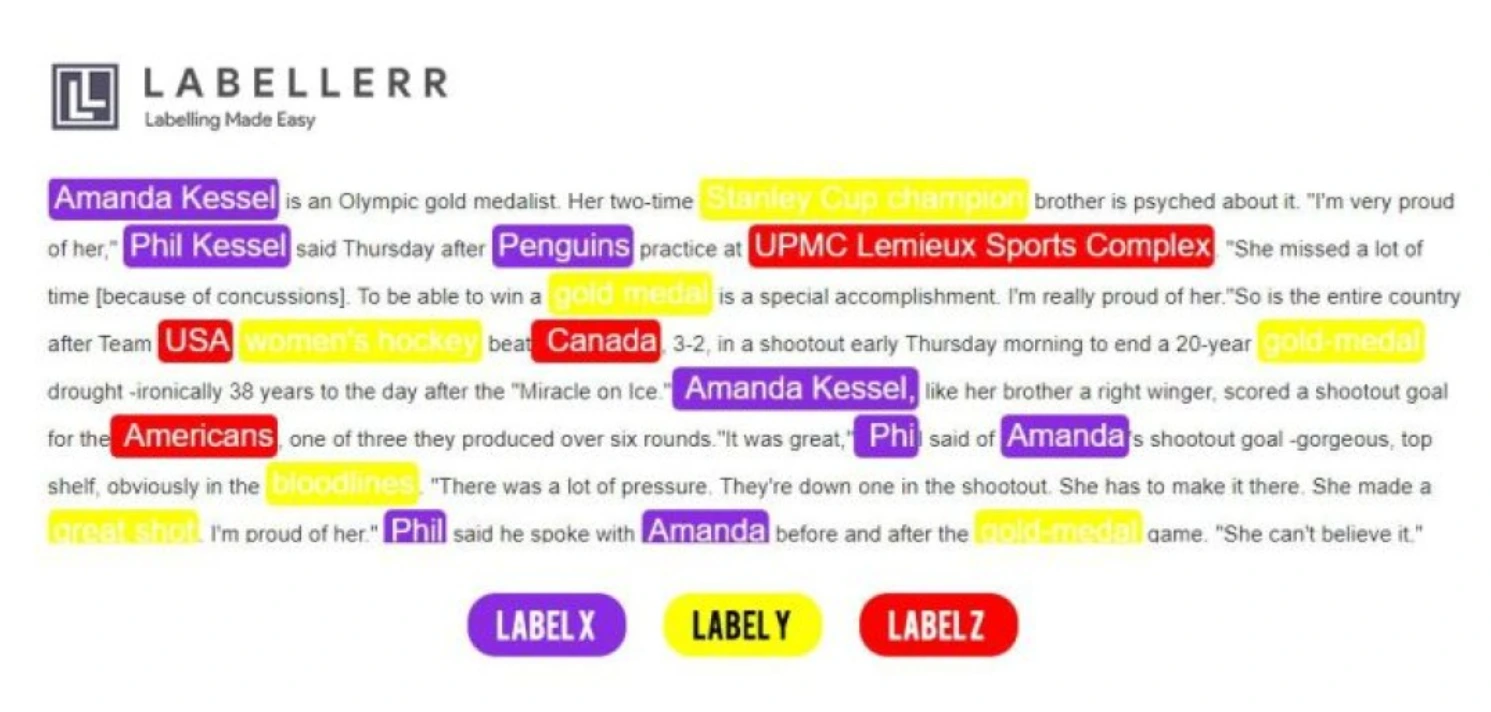
Labellerr stands out as the most comprehensive data annotation solution engineered specifically for enterprise ML teams facing complex data challenges. Unlike general-purpose tools, Labellerr combines military-grade security with industry-leading annotation speed.
Why top ML teams choose Labellerr:
- Our AI-assisted labeling accelerates your workflow, cutting project timelines from months to weeks.
- Connects directly with your existing ML infrastructure, eliminating workflow disruptions and technical debt.
- Validation workflows and consensus mechanisms ensure 99.9% annotation accuracy.
- Available as a secure cloud SaaS solution, depending on your requirements.
- Manage complex projects across distributed teams with role-based permissions.
- Transparent pricing that scales with your projects.
Labellerr customers typically see a 67% reduction in time-to-model deployment and 40% lower annotation costs compared to traditional methods.
Looking for immediate results? Start your free Labellerr trial today

(iii) Affordable Pricing: Labellerr offers flexible pricing structures suitable for various project sizes. There are no lengthy contracts, allowing for use in proof-of-concept or long-term projects as needed.
(iv) Quality Assurance: Labellerr emphasizes high-quality data annotation and includes quality control as an integral part of the annotation process. This ensures the accuracy and reliability of AI and ML models.
(v) Ease of Use and Integration: The platform offers a user-friendly interface, templates for annotations, and seamless integration with existing MLOps infrastructure, ensuring smooth integration into production pipelines.
(vi) Automated Annotation Features: Labellerr provides automated image segmentation and object detection features. These capabilities simplify and speed up the annotation process, making model training more efficient and effective.
Cons:
Limited Format Support: Does not currently support point cloud and 3D data formats.
Pricing:
Pro Plan: Starts at $499 per month for 10-user access with 50,000 data credits included. Additional data credits can be purchased at $0.01 USD per data credit, and extra users can be subscribed to at $29 USD per user.
Enterprise Plan: Offers professional services, including tool customization and ML consultancy.
Accelerate your annotation process with Labellerr's Segment Anything Model. Experience its efficiency in action by viewing our comprehensive feature demonstration video below:
In the rapidly evolving AI landscape, choosing the right annotation AI tool is critical for building accurate and efficient machine learning models. Labellerr stands out by offering a powerful annotation AI tool that combines automation with customization, enabling teams to label data faster without compromising quality. Its user-friendly interface and integration capabilities make it ideal for diverse AI projects, from computer vision to natural language processing.
With automated features like image segmentation and object detection, Labellerr accelerates the annotation process, reducing manual effort and improving model training outcomes. Labellerr is a comprehensive solution for organizations seeking to optimize their AI data preparation workflows.
Discover how Labellerr’s flexible pricing and customizable annotation AI tool can accelerate your AI projects while ensuring data security and high-quality results. Contact us today for a free demo and personalized consultation to see how we can support your AI Project.
2. Labelbox

Labelbox is a powerful tool used to label or mark different types of data, making it understandable for computers. It allows users to annotate various data types like images, videos, text, documents, audio, medical imagery, and geospatial data.
The platform provides a comprehensive set of annotation tools, such as creating bounding boxes around objects in images, segmenting parts of an image, marking points, drawing polygons or polylines, and classifying different elements within the data.
One of its key features is its support for various data formats and annotations for tasks related to computer vision, natural language processing, and other AI-related projects.
Labelbox offers functionalities like:
(i) Efficient Labeling: Combining automation tools with pre-labeling techniques to speed up the labeling process without compromising quality.
(ii) Custom Workflows: Allowing users to create tailored workflows based on specific attributes or requirements, which can enhance the quality and efficiency of labeling tasks.
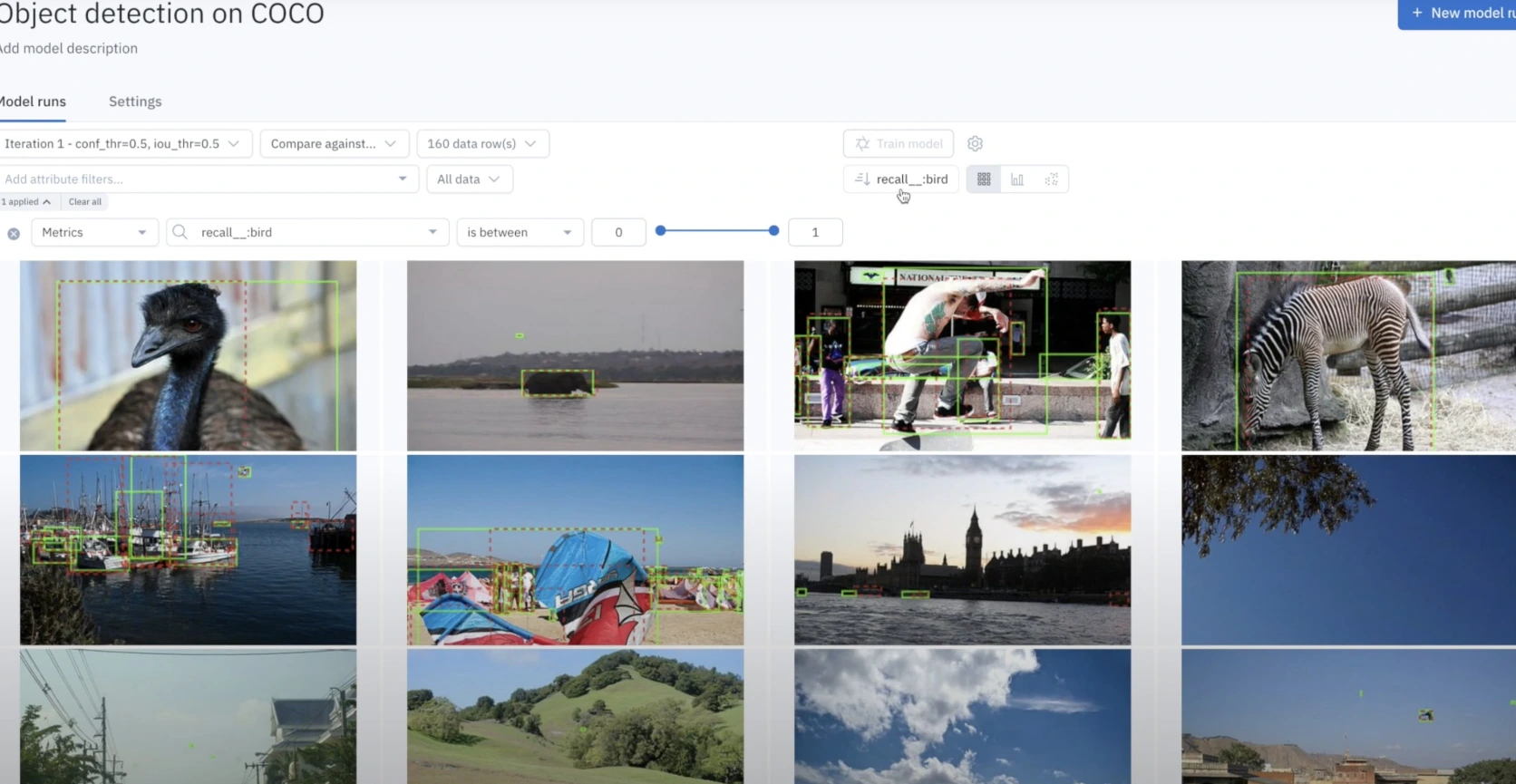
(iii) Flexible Workforce: Providing access to an industry-leading labeling workforce with expertise in different domains and languages. Users can use internal or external labeling teams or opt for Labelbox's specialized labeling service, Labelbox Boost.
(iv) Unified Platform: Enabling the management of multiple data labeling projects within a single platform. It allows the integration of internal and external teams for high-quality data labeling.
(iv) Analytics and Collaboration: Offering detailed analytics to track throughput, efficiency, and quality across different labeling teams. It also provides collaboration tools for real-time communication among team members.
Labelbox is designed to simplify and accelerate the process of preparing data for AI and machine learning models. Its goal is to make data labeling more efficient, accurate, and collaborative, catering to various industries and use cases requiring annotated data for AI training.
3. SuperAnnotate

SuperAnnotate is a tool used to label or mark different types of data so that computers can understand it better. It's a top-quality annotation tool that works with various kinds of data like images, videos, text, LiDAR (a technology used for measuring distances), audio, and more.
It helps people label data faster without compromising on accuracy, allowing them to collaborate with others to improve the quality of annotations. SuperAnnotate also offers automation features to streamline the labeling process.
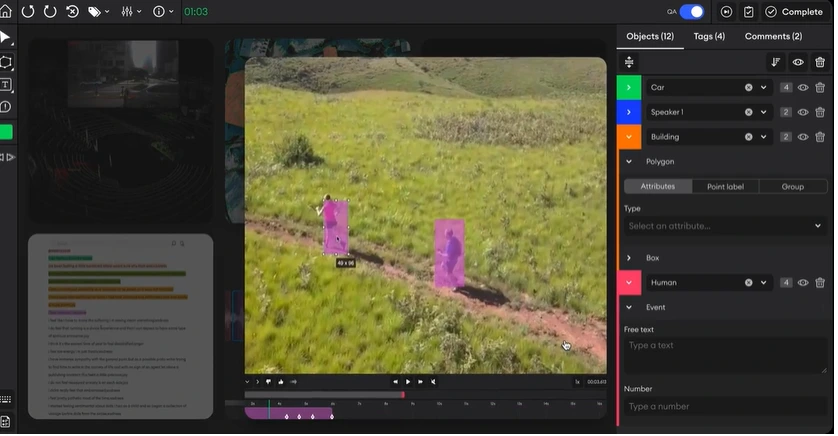
Here are some key points about the tool:
(i) Types of Annotations: It offers different annotation tools tailored for specific tasks. For images, it helps with things like detecting objects, classifying items, estimating poses, and even reading text within images. For videos, it helps in tracking objects, classifying actions, and more.
(ii) For Various Data Types: SuperAnnotate isn't limited to just images and videos; it can also annotate text, audio, and LiDAR data, which is used for mapping in things like autonomous vehicles.
(iii) Quality and Automation: The tool is built with a focus on quality, providing automation tools to speed up annotation without compromising accuracy. There's a collaboration system that allows stakeholders to review annotations easily, making teamwork smoother.
(iv) Different Industries: It's used across various industries like agriculture, healthcare, robotics, insurance, sports, and more. This means it's versatile and can be helpful in different fields where annotated data is needed for training AI models.
(v) Services and Management: SuperAnnotate offers access to a global marketplace of specialized annotation teams, project management features, and tools to manage and organize data for AI more effectively.
4. Appen
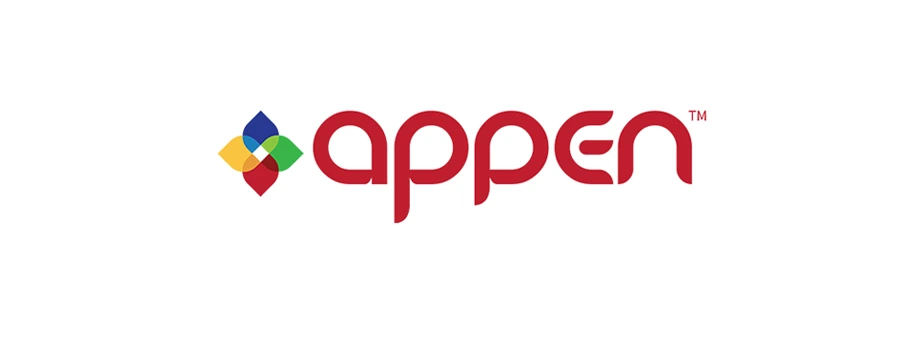
Appen provides a tool for data annotation, that assists in labeling or marking data so that computers can understand it better.
Their tool helps with various types of data like images, videos, text, and more. Appen's focus is on making sure this labeled data is accurate and useful for training AI models.
The tool allows people to:
(i) Label Different Types of Data: It helps in marking things in images, identifying objects in videos, and making text understandable for computers.
(ii) Prepare Data for AI: By labeling data accurately, Appen helps in training AI systems to recognize patterns and make better decisions.
(iii) Improve AI Accuracy: Labeled data created using Appen's tool helps AI systems become more accurate and efficient in various tasks.
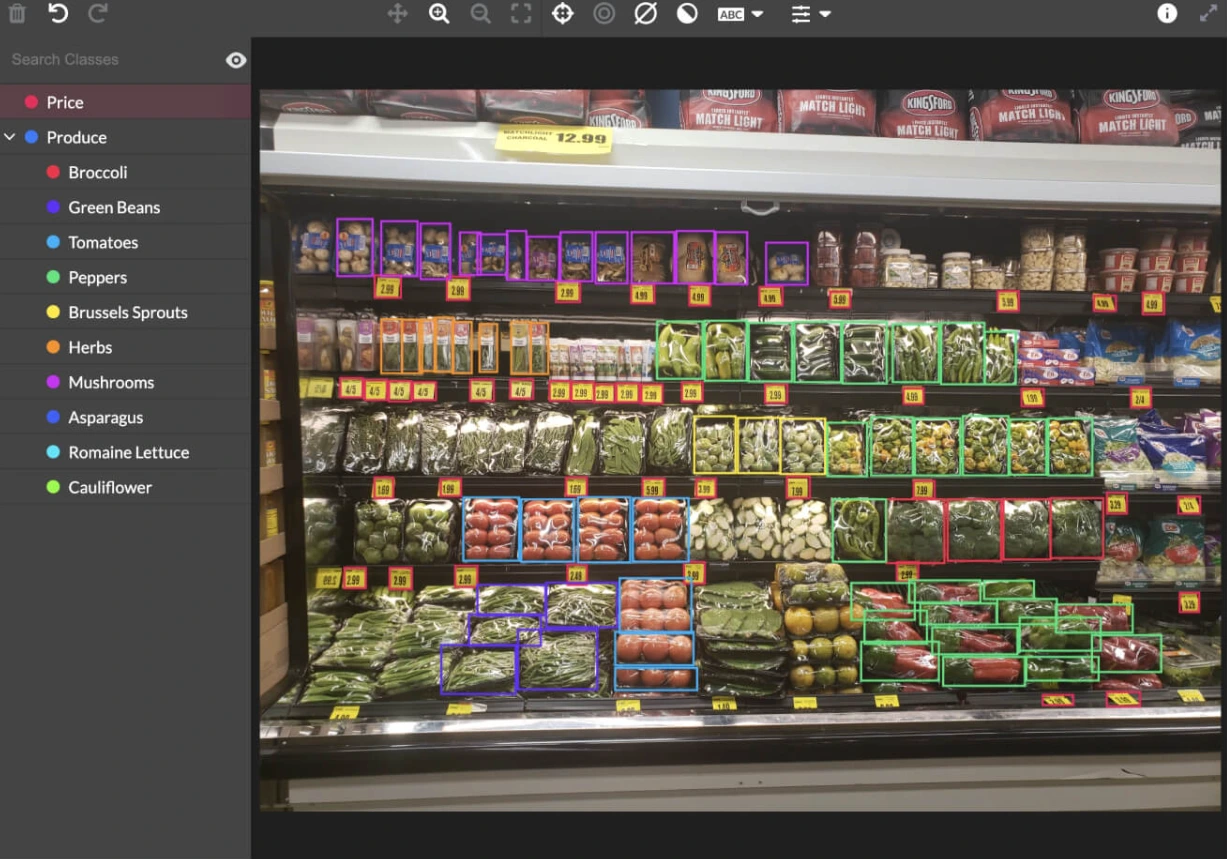
Appen provides a tool that helps in marking and organizing data so that computers can learn from it more effectively. This labeled data is crucial for training AI systems across different industries and applications.
5. V7

V7 is a powerful tool that helps companies with data annotation for Artificial Intelligence (AI). It's designed to make the process of labeling data much faster and more accurate for various AI applications.
Here's what V7 offers:
(i) Labeling Speed: V7 allows users to label data for AI models at a much faster pace, around 10 times quicker than traditional methods. This speed applies to tasks related to computer vision and generative AI.
(ii) Customer Testimonials: Successful users from different industries, such as Abyss Solutions, Imidex, and Genmab, have praised V7 for its reliability, customizable workflows, and user-friendly interface.
(iii) Generative AI: V7 has a feature called AutoAnnotate that boosts annotation speed and accuracy. It allows for the quick creation of polygon masks (like outlines) for images while maintaining high quality.
(iv) Data Organization: It helps in gathering and organizing training data for AI in a single location. This includes tools for handling different data formats, version control, and viewing, sorting, and filtering data.

(v) Model Management: Users can either use their own AI models or access pre-trained ones within V7. It helps in building a library of models, combining them with human annotation, and creating efficient workflows.
(vi) Workflow Automation: V7 streamlines the annotation process by automating tasks, assigning the right jobs to the right people, and ensuring data security and quality control.
(vii) Data Engine Features: V7 provides various tools for annotation across images, videos, and documents. It allows managing datasets securely, creating efficient workflows, and accessing annotation services or open datasets.
6. Amazon SageMaker Ground Truth
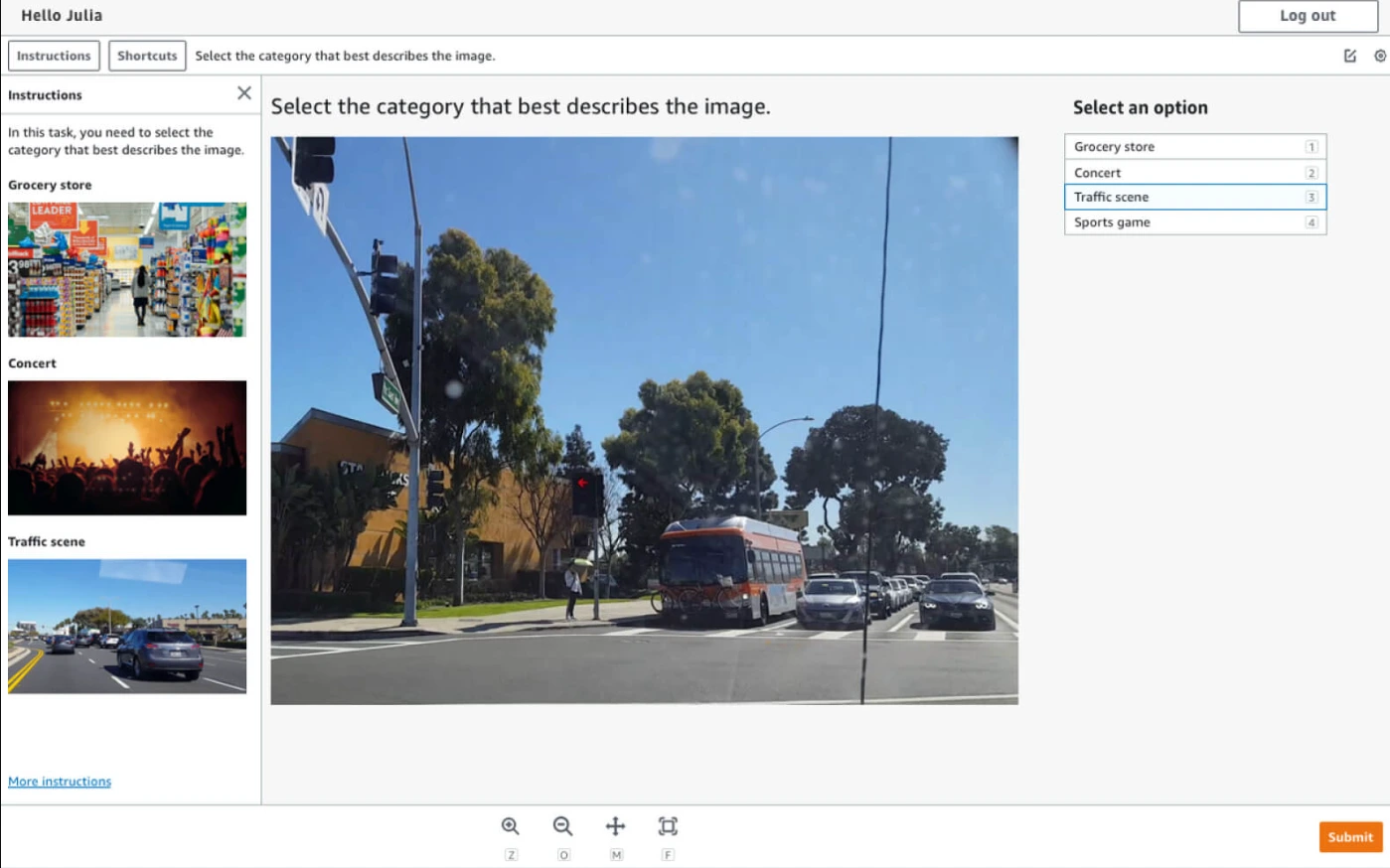
Amazon SageMaker Ground Truth is a tool that helps companies label their data quickly and accurately to train artificial intelligence (AI) models. It's like a special assistant that makes it easier for people to mark or annotate different types of data, like images or text, so that computers can learn from it.
Here's what Amazon SageMaker Ground Truth does:
(i) Data Labeling: It helps in marking or labeling data, such as drawing boxes around objects in images or identifying specific parts of text. This labeled data is then used to teach AI systems.
(ii) Accuracy and Speed: The tool focuses on making sure the labels are correct and the work gets done faster. It helps in handling large amounts of data efficiently.
(iii) Automation: SageMaker Ground Truth also uses automation to speed up the labeling process. It can learn from the work done by humans and apply that learning to label more data automatically.
(iv) Integration with Amazon Services: Since it's an Amazon tool, it easily connects with other Amazon services, making it simpler for businesses using Amazon's AI solutions.
7. Dataloop
Dataloop is an end-to-end data annotation platform that helps ML teams create high-quality datasets faster and more efficiently. It combines the power of human intelligence with smart automation tools to streamline the data labeling process, ensuring accuracy and reducing manual workload.
Key Features
(i) Accurate Labeling at Speed: Generate unlimited datasets with precise guidelines and complex ontologies. Use smart algorithms, guidance tools, and pre-trained models to automate repetitive tasks and significantly reduce labeling time.
(ii) Real-time Validation and Feedback: Enjoy real-time visibility of the annotation process with instant feedback and data QA. Catch and correct errors immediately, preventing them from impacting your models.
(iii) Integrated Solutions for Data Annotation Teams: Dataloop offers a suite of tools and features designed specifically for data annotation teams, including annotation studio tools, video annotation, workforce management, data QA & verification, and integrated labeling services.
Benefits of Dataloop
- 60-90% Faster Labeling: By automating repetitive tasks and pre-annotating data, Dataloop significantly reduces the time it takes to label your datasets.
- Improved Accuracy: Real-time feedback and data QA tools help ensure the accuracy of your labeled data, leading to better-performing AI models.
- Reduced Costs: Faster labeling and improved accuracy mean you can spend less time and money on data preparation.
- Scalability: Dataloop can handle large and complex datasets with ease, making it ideal for growing AI teams.
Dataloop is versatile and can be used to accelerate AI development in a wide range of industries including Retail, Drones and Aerial Imagery, Robotics, Autonomous Vehicles, Precision Agriculture and Media & Content.
Why Choose Labellerr's Annotation Tools Over Competitors?
When comparing annotation tools, Labellerr stands out with unique advantages:
1. Custom Workflow Builder: Annotation workflows specific to your projects need.
2. Automated Annotation: Our AI-powered annotation tools automatically label up to 80% of your data, reducing manual effort.
3. Pay-As-You-Go Pricing: Start with our flexible pricing at just $499/month - much more affordable than competitors requiring annual contracts.
4. Seamless MLOps Integration: Our annotation tools connect directly with your existing ML pipeline for continuous model improvement.
Ready to transform your data labeling process? Try Labellerr's annotation tools free for 14 days - no credit card required.
Read our other listicles:
1. 7 Best Text Annotation & Labeling Tools In 2025
2.7 Best Audio Annotation Labeling Tools In 2025
Real-World Data Labeling Applications
Computer Vision Excellence
ML teams developing object detection models can reduce labeling time by up to 80% using Labellerr's automated annotation features. Our Segment Anything Model integration pre-labels common objects, requiring only minor adjustments rather than drawing from scratch.
NLP & Document Processing
Institutions using Labellerr have achieved 99.8% accuracy in document classification and entity extraction, essential for compliance and fraud detection systems.
Healthcare & Medical Imaging
Medical research teams use Labellerr's specialized annotation tools to label complex medical images with higher precision while maintaining strict HIPAA compliance.
Autonomous Vehicle Development
Automotive AI developers leverage Labellerr to annotate massive video datasets, using our annotation features to track objects across frames with minimal manual intervention.
Why Choose the Right Data Labeling Tool in 2025
The quality of your AI models depends directly on the quality of your training data. As ML applications become more sophisticated and widespread across industries, choosing the right data labeling tool becomes increasingly critical to project success.
While open-source options like Label Studio offer basic functionality, enterprise teams tackling complex AI challenges require comprehensive solutions like Labellerr that address the entire annotation workflow - from security and speed to quality.
Labellerr stands out as the complete data annotation solution for teams that can't compromise on data quality or security. Our platform balances powerful automation with human oversight, ensuring that your AI models are trained on the most accurate data possible.
Ready to transform your data labeling workflow? Book a personalized Labellerr demo
Frequently Asked Questions About Data Labeling Tools
What makes a data labeling tool enterprise-ready?
Enterprise-ready data labeling tools offer security features, scalable infrastructure, team management capabilities, and seamless integration with existing MLOps workflows. Labellerr provides all these features plus dedicated support.
How much can AI-assisted labeling speed up the process?
With advanced tools like Labellerr, teams regularly see 5- 10X speed improvements compared to manual labeling. Our customers report completing in days what previously took weeks.
Which data formats should a good labeling tool support?
Comprehensive tools should support images, videos, text, audio, and documents. Labellerr supports all these formats.
How important is quality control in the data labeling process?
Quality control is critical - poor labels lead directly to poor model performance. Labellerr's built-in consensus mechanisms, label review workflows, and automated quality checks ensure the highest data quality standards.
Can data labeling tools integrate with my existing ML infrastructure?
Yes, advanced tools like Labellerr offer API access, webhook integration, and direct connections to popular ML platforms, allowing seamless incorporation into your existing workflows without disruption.

Simplify Your Data Annotation Workflow With Proven Strategies
.png)


